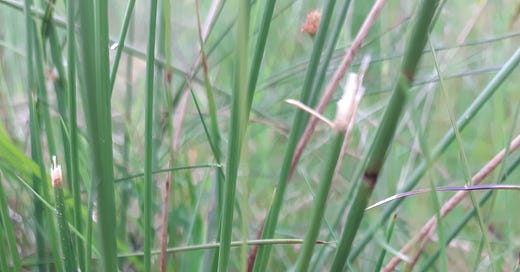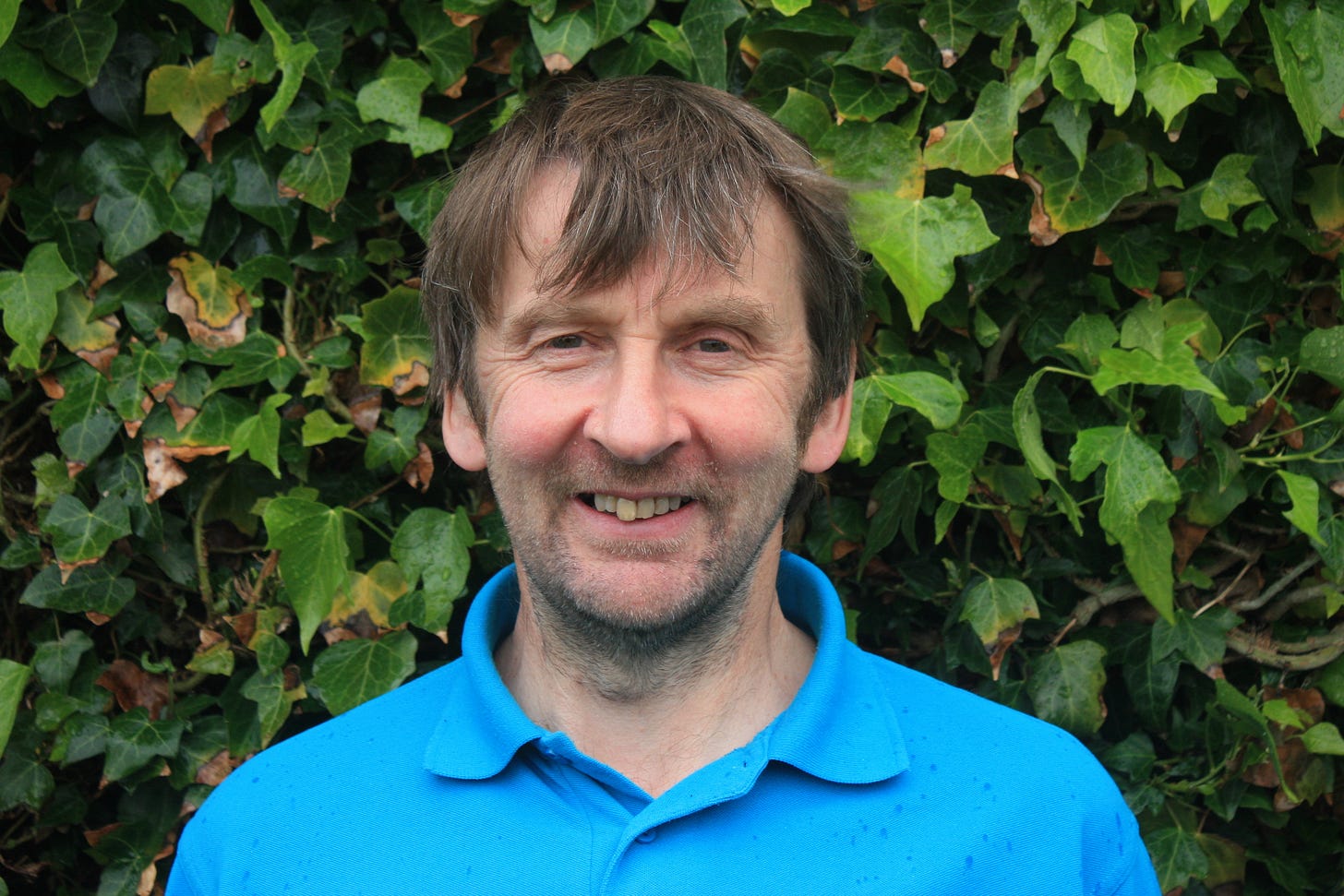The Battles of Nature: The Cuckoo, The Caterpillar and the Perigrine Falcon.
A guided walk with Andy bore witness to the wonders and perils of wildlife in north highland
It pays to be alert and yesterday, it wasn’t just me who got a shock!
I always look forward to the first call of the cuckoo each year.On our guided walk, I was surprised by the number of cuckoos still around, calling frenetically from the hillside over Lochinver.
One reason we still get plenty of cuckoos in this part of the world is the abundance of big hairy caterpillars all over the heather and on the paths. My story starts with one such caterpillar. To be precise, it was a two-year-old caterpillar of a drinker moth, as long and thick as my little finger and covered in long, fine hairs. It was doing what caterpillars do best—munching its way through the mollinia grass and delicious sedges that cover most of the hills around here. If you've ever walked in the Highlands of Scotland, you cannot miss seeing these hirsute monsters. And if you are like me and have seen them hanging in the vegetation on a frosty day in the middle of February, with the temperature well below freezing, you will be amazed at how they can survive at all. I suppose they must have some type of antifreeze in their blood.
The drinker moths are one of four big caterpillars you might come across in the hills. All of them spend two years as a caterpillar before hatching into large day-flying moths. Along with the drinker, there are the fox moth, the northern eggar, and the emperor moth. Being big and hairy, they do not have much to fear. Most birds find them too hairy to deal with. Great tits are one of the few small birds that will try.
Recently, I was entertained for ages watching a pair of great tits grappling with a large hairy fox moth caterpillar. They repeatedly smashed it against the stem of a spiny gorse bush. At first, I thought they were just trying to kill it, but after five minutes, I realized they were likely trying to prepare the meal sufficiently by removing all those long hairs so they could swallow it. Or maybe they were just trying to shake the toxins out before eating. It took nine minutes and thirty-two seconds (to be precise) of caterpillar bashing before they were finally swallowed. Then the great tits had to spend about the same amount of time cleaning themselves and wiping their bills.

One bird that specializes in caterpillars, the bigger and hairier the better, is the cuckoo. Cuckoos will fly over 10,000 miles from Senegal or Gambia just to feed on caterpillars in the North Highlands. Whereas the population in England has crashed in the last few years (more on that later), we still seem to have a good number of birds with us this year. The first cuckoo reported to me this year was on the 22nd of April near Achiltibuie, but perhaps you know better!

Anyway - back to my story. While I was watching the drinker moth caterpillar, it was just a coincidence that the most feared predator of the caterpillar happened to fly past. I trained my binoculars on the fast-flying cuckoo. Its distinctive long tail trailed behind as it flew over the gorse. A host of little meadow pipits followed, mobbing and harrying the large invader. Deep in their psyche, they probably know that cuckoos are bad news and their nest of eggs is not safe when a female cuckoo flies over looking to offload its youngster on some unsuspecting foster parents. As we all know, once a cuckoo egg hatches, the cuckoo chick ejects the legitimate occupants and then gets fed by its new and unsuspecting foster parents—true masters of deception. It is said that the cuckoo's hawk-like plumage helps them avoid attacks from small birds whose nests they are trying to invade, but today it was not working.
Then a real raptor arrived, and total mayhem broke out.
The raptor focused not on the meadow pipits but on the cuckoo itself! The tables had turned, and suddenly the cuckoo was in deadly peril. A large female peregrine will easily kill and eat a cuckoo. Peregrines can fly at 60 miles per hour in level flight and stoop at speeds up to an incredible 200 miles an hour. The cuckoo didn’t stand a chance, or so I thought.
The cuckoo did the only thing it could and flew straight vertically upwards into the sky, gaining height all the time. Peregrines are not designed to fly upwards, but this gave the cuckoo a slight chance. We tracked the cuckoo as it got higher and higher into the sky. Caught in the drama of it all, I realised I was not breathing. My neck was also aching from holding the binoculars above my head. Despite the clever cuckoo tactics, the peregrine was gaining fast, and it looked certain to catch the cuckoo when something else happened.
Whether this was a voluntary action, I will never know, but the next thing I saw was a streak of white eject from the back of the cuckoo. The peregrine was moving so fast it could not make any evasive maneuvers and got a face full of cuckoo guano. The peregrine banked sharply away, and who could blame it? The cuckoo had escaped to live another day.
Everyone let out their breath….and then everything went back to normal. The caterpillar kept munching, the peregrine went to the nearest crag to cover its embarrassment and clean itself off, and the cuckoo went over the hill in search of more caterpillars and perhaps an unguarded meadow pipit nest. Such is life in the wilds of the North Highlands.
Recent radio-tracking of cuckoos has shown just how much we do not know about these amazing birds. For example, it seems that Scottish cuckoos choose a different flight path when they migrate to Africa and back. They travel down through Spain and Gibraltar, across the Mediterranean, and on to Senegal. English cuckoos seem to prefer a route that goes more on the east side of the Mediterranean—a much more dangerous route due to hunters in places like Malta, Cyprus, and Italy. It is estimated that between 11 million and 36 million birds are illegally killed or taken in Mediterranean countries every year, many of them while migrating according to the Guardian in December 2021. Could this be why “English” cuckoos are declining while “Scottish” cuckoos are just about holding their own?
As you can imagine there was much laughter and mirth amongst the group following this event on the walk. I can’t promise dramatic events like this everytime, but usually we see something unfold - as nature never sits still.
Andy Summers, North Highland's Senior Ranger for High Life Highland, is a dedicated naturalist with a deep understanding of the region's diverse ecosystems. His extensive experience in wildlife conservation and passion for preserving North Highland's pristine landscapes make him a vital asset. Andy's work encompasses wildlife observation, environmental education, and passing on a greater appreciation for the area's unique flora and fauna. His commitment to conserving North Highland's natural heritage is evident in his expertise and unwavering dedication.
If you liked this post -read other tales of a remarkable encounters in nature from Nature Unveiled.
An Extraordinary Battle - Eagle vs. Seal
I had just completed a fine guided walk with a customer on a cold clear frosty day around the south side of Scourie bay, the highlight of which was a splendid Great Northern Diver in the bay. Otter signs were very present, with numerous trails from the sea through little freshwater ponds and their associated small green mo…
Predator on the Wing
I'd like to share my experience from a guided walk I led recently, where the participants and I ended up receiving a bit more than we had anticipated. The walk started as normal. It was nice group of people, the weather was fair, and everyone was chatting amicably. A lizard basked on the sun soaked Torridon…
and More about the plight of the cuckoo in this earlier blog:
Echoes of a Gaelic Spring: The Cuckoo's Call and Conservation
Today, I heard my first cuckoo of 2024 and immediately my mind went to the same Gaelic words that it does every year: O fàilte ort fhèin, a chuthag ghorm, Led òran ceòlmhor milis! 'S e seirm do bheòil sa Chèitein òig A thogadh bròn o m' chridhe 'S ro-bhinn leam t'fhuaim 's a' mhaduinn chéit',










